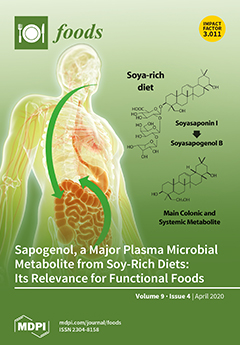The composition of microbiota and the content and pattern of bioactive compounds (biogenic amines, polyphenols, anthocyanins and flavanols), as well as pH, color, antioxidant and reducing properties were investigated in fermented Criollo cocoa beans and shells. The analyses were conducted after fermentation and
[...] Read more.
The composition of microbiota and the content and pattern of bioactive compounds (biogenic amines, polyphenols, anthocyanins and flavanols), as well as pH, color, antioxidant and reducing properties were investigated in fermented Criollo cocoa beans and shells. The analyses were conducted after fermentation and drying (T1) and after two thermal roasting processes (T2, 120 °C for 22 min; T3, 135 °C for 15 min). The fermentation and drying practices affected the microbiota of beans and shells, explaining the great variability of biogenic amines (BAs) content. Enterobacteriaceae were counted in a few samples with average values of 10
3 colony forming units per gram (CFU g
−1), mainly in the shell, while
Lactobacillus spp. was observed in almost all the samples, with the highest count in the shell with average values of 10
4 CFU g
−1. After T1, the total BAs content was found to be in a range of 4.9÷127.1 mg kg
−1DFW; what was remarkable was the presence of cadaverine and histamine, which have not been reported previously in fermented cocoa beans. The total BAs content increased 60% after thermal treatment
T2, and of 21% after processing at
T3, with a strong correlation (
p < 0.05) for histamine (ß = 0.75) and weakly correlated for spermidine (ß = 0.58), spermine (ß = 0.50), cadaverine (ß = 0.47) and serotonine (ß = 0.40). The roasting treatment of
T3 caused serotonin degradation (average decrease of 93%) with respect to unroasted samples. However, BAs were detected in a non-alarming concentration (e.g., histamine: n.d ÷ 59.8 mg kg
−1DFW; tyramine: n.d. ÷ 26.5 mg kg
−1DFW). Change in BAs level was evaluated by principal component analysis. PC1 and PC2 explained 84.9% and 4.5% of data variance, respectively. Antioxidant and reducing properties, polyphenol content and BAs negatively influenced PC1 with both polyphenols and BA increasing during roasting, whereas PC1 was positively influenced by anthocyanins, catechin and epicatechin.
Full article






